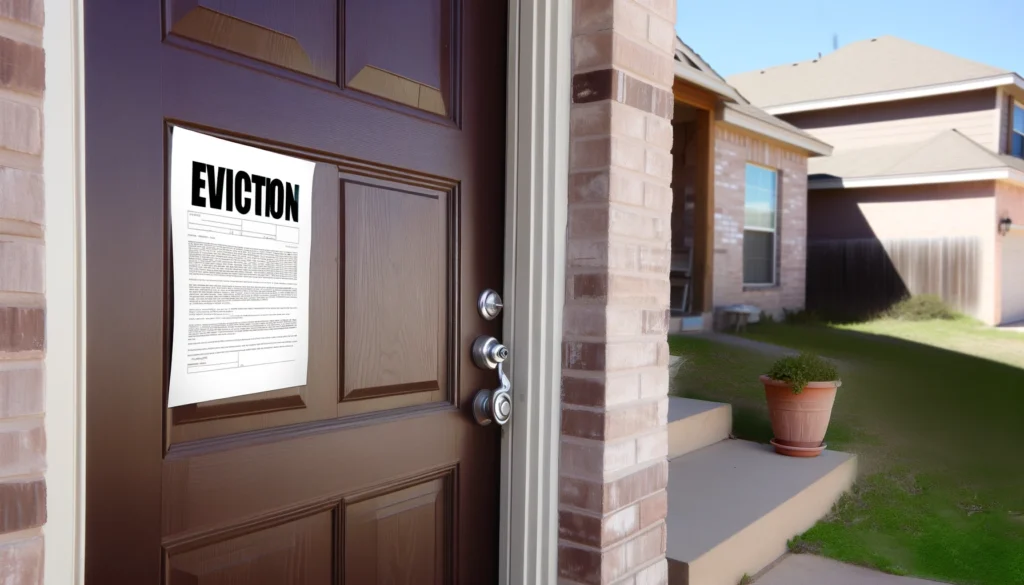A Step-by-Step Guide for Dallas-Fort Worth Landlords
Table of contents
- Step 1: Understanding Grounds for Eviction
- Step 2: Serving the Eviction Notice
- Step 3: Filing the Eviction Lawsuit
- Step 4: Attending the Eviction Hearing
- Step 5: Enforcing the Writ of Possession
- Step 6: Recovering Unpaid Rent and Damages
- Conclusion: Navigating the Eviction Process with NTX Eviction
- Frequently Asked Questions About the Eviction Process in Texas
Eviction can be a challenging and stressful experience for landlords, especially when dealing with tenants who fail to pay rent or violate lease terms. Understanding the eviction process in Texas is essential to navigate these situations effectively and legally. This comprehensive guide will walk you through each step of the eviction process, ensuring you are well-equipped to handle tenant issues and protect your property rights.

Step 1: Understanding Grounds for Eviction
Before initiating the eviction process, it’s crucial to understand the grounds for eviction in Texas. Common reasons include:
- Non-Payment of Rent: The most common reason for eviction is non-payment of rent. If your tenant fails to pay rent, you have the right to start the eviction process.
- Lease Violations: These can include unauthorized occupants, pets, property damage, or illegal activities on the premises.
- Holdover Tenants: Tenants who remain on the property after their lease has expired without renewing the lease or without your permission.
- No Lease/End of Lease: For tenants without a formal lease agreement or when the lease has ended, you may need to proceed with eviction if they refuse to leave.
Step 2: Serving the Eviction Notice
The eviction process officially begins with serving the tenant an eviction notice. This step is crucial and must be executed correctly to avoid legal complications.
Types of Eviction Notices
- Notice to Pay Rent or Quit: This notice is used when the tenant has failed to pay rent. It typically gives the tenant three days to pay the overdue rent or vacate the property.
- Notice to Cure or Quit: This notice is used for lease violations. It gives the tenant a specific amount of time (usually three days) to correct the violation or leave the property.
- Notice to Quit: This is used for severe lease violations or illegal activities. The tenant must vacate the property immediately, with no option to cure the violation.
- Notice to Vacate: For holdover tenants or tenants without a lease, this notice informs the tenant they must leave the property within a specified period, usually 30 days.

How to Serve the Notice
To ensure the eviction notice is legally valid, it must be served properly. In Texas, acceptable methods include:
- Personal Delivery: Handing the notice directly to the tenant.
- Mail: Sending the notice via certified mail with a return receipt requested.
- Posting: If the tenant is unavailable, you can post the notice on the inside of the main entry door.
Step 3: Filing the Eviction Lawsuit
If the tenant does not comply with the eviction notice within the specified period, the next step is to file an eviction lawsuit, also known as a forcible detainer suit, at the local Justice of the Peace Court in the county where the property is located.
Preparing for the Lawsuit
When filing the lawsuit, you will need to gather and submit the following documents:
- Eviction Notice: A copy of the notice you served to the tenant.
- Lease Agreement: A copy of the lease agreement, if applicable.
- Proof of Non-Compliance: Evidence that the tenant has not complied with the eviction notice (e.g., unpaid rent receipts, photos of lease violations).
- Filing Fee: The court will charge a filing fee, which varies by county but typically ranges from $75 to $150.
Filing the Lawsuit
- Complete the Petition: First, fill out the eviction petition form, which you can obtain from the Justice of the Peace Court. This form requires details about the tenant, the property, the reason for eviction, and, if applicable, the amount of rent owed. Additionally, ensure all information is accurate and complete to avoid any delays in the process.
- Submit the Petition: File the completed petition with the Justice of the Peace Court and pay the filing fee.
- Serve the Summons: The court will issue a summons to the tenant, informing them of the lawsuit and the date of the eviction hearing. This summons is usually served by a constable or sheriff.
Step 4: Attending the Eviction Hearing

After filing the lawsuit, the court will schedule an eviction hearing. Both you and the tenant will have the opportunity to present your cases to the judge.
Preparing for the Hearing
To increase your chances of a favorable outcome, prepare the following:
- Documentation: Bring copies of the eviction notice, lease agreement, proof of non-compliance, and any other relevant documents.
- Witnesses: If possible, bring witnesses who can testify to the lease violations or non-payment of rent.
- Evidence: Present clear evidence of the tenant’s non-compliance, such as photos, videos, or written communications.
Presenting Your Case
At the hearing, clearly and concisely present your case to the judge. Explain why you are seeking eviction, provide evidence to support your claims, and answer any questions the judge may have. The tenant will also have an opportunity to present their defense.
Receiving the Judgment
If the judge rules in your favor, they will issue a judgment for possession. This judgment orders the tenant to vacate the property by a specified date. However, if the tenant does not comply, you can proceed with the next step.
Step 5: Enforcing the Writ of Possession
If the tenant refuses to leave after the court’s judgment, you will need to obtain a writ of possession. You can request this writ from the court. Subsequently, this writ authorizes law enforcement to remove the tenant and their belongings from the property.
Obtaining the Writ
- Request the Writ: Next, contact the Justice of the Peace Court to request a writ of possession. Additionally, be aware that there is usually a fee for this service.
- Serve the Writ: The writ will be served to the tenant by a constable or sheriff, who will schedule a date for the tenant’s removal.
Enforcing the Writ
On the scheduled date, the constable or sheriff will arrive at the property to remove the tenant and their belongings. Additionally, as the landlord, you should be present to take possession of the property and change the locks to prevent re-entry.

Step 6: Recovering Unpaid Rent and Damages
After regaining possession of your property, you may still need to address any unpaid rent or property damages caused by the tenant.
Filing a Small Claims Lawsuit
If the tenant owes you money for unpaid rent or damages, you can file a small claims lawsuit to recover these costs. The process involves:
- Documenting Damages: Take photos and document any damages to the property.
- Calculating Costs: Calculate the total amount owed, including unpaid rent, repair costs, and any other expenses.
- Filing the Lawsuit: File the small claims lawsuit with the Justice of the Peace Court, providing evidence of the damages and the amount owed.
Attending the Hearing
Attend the small claims hearing with all necessary documentation and evidence to present your case. If the judge rules in your favor, they will issue a judgment for the amount owed. You can then attempt to collect this amount from the tenant.
Conclusion: Navigating the Eviction Process with NTX Eviction
The eviction process in Texas can be complex and time-consuming. However, understanding each step can help you navigate it effectively. By following this guide, you can handle tenant issues legally and efficiently. Additionally, this will help protect your property rights and investments.
Contact Us-Free Consultation
If you need professional assistance with the eviction process, NTX Eviction is here to help. Our team specializes in handling evictions in the Dallas-Fort Worth Metroplex. We provide expert guidance and support every step of the way. Additionally, we ensure you navigate the eviction process smoothly and efficiently. Contact us today to learn more about our services and discover how we can help you manage tenant issues with confidence.
Frequently Asked Questions About the Eviction Process in Texas
Understanding Eviction Procedures in Texas
Common reasons for eviction in Texas include non-payment of rent. Additionally, lease violations such as unauthorized pets or occupants, property damage, and illegal activities on the property can lead to eviction. Furthermore, tenants staying beyond the lease term, known as holdover tenants, are also grounds for eviction.
The eviction process in Texas typically takes between three to six weeks, depending on the specific circumstances and the court’s schedule. This includes serving the eviction notice, waiting for the notice period to expire, filing the eviction lawsuit, attending the court hearing, and potentially enforcing a writ of possession.
Yes, you can evict a tenant without a written lease agreement in Texas. You must still provide a written notice to vacate, usually giving the tenant at least 30 days to leave. If the tenant does not comply, you can then file an eviction lawsuit.
If the tenant does not leave after the eviction notice period, you need to file an eviction lawsuit, also known as a forcible detainer suit, with the local Justice of the Peace Court. This legal action will then initiate the formal eviction process and lead to a court hearing where you can present your case.
Yes, it is necessary to attend the eviction hearing. As the landlord, you need to present your case to the judge, provide evidence of the tenant’s non-compliance, and answer any questions. Furthermore, failing to attend the hearing could result in the case being dismissed or delayed.
